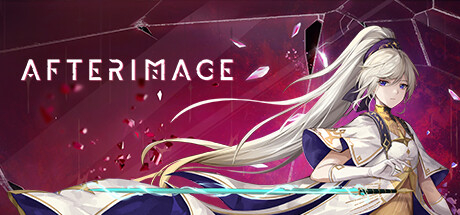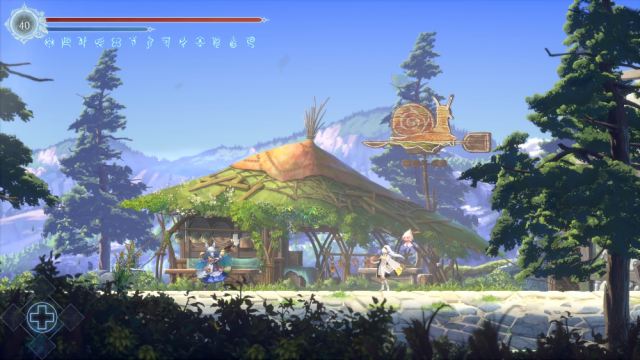Existing User Log In
New User Registration
Register for a free account to gain full access to the VGChartz Network and join our thriving community.





America - Front


America - Back

In the years since Dark Souls, many aspiring developers have attempted to fuse the mechanics of the Souls-like with the structure of a Metroidvania. This has led to a lot of successful titles, but rarely one that embraces the rules of each sub-genre in equal measure. Usually, you get a Souls-like with concessions to a Metroidvania, or a Metroidvania with some borrowed Souls-like qualities. Afterimage, conversely, is about as close to a 50-50 split as you can get. As a result, it should speak to fans of both concepts to the same degree.
Afterimage takes place years after a cataclysmic event called the Razing, which almost ended human civilization in the land of Engardin. Players take control of Renee, an amnesiac who, along with her fairy-like companion Ifree, safeguards the bodies of the dead around her village. When the village is attacked by mysterious monsters, and the soul of Renee's mentor, Aros, is taken away by an unknown cloaked person, Renee and Ifree set out on a quest to make things right.

The storytelling in Afterimage is simultaneously one of its best and most frustrating features. The world that developer Aurogon Shanghai dreamed up is incredibly rich, with detailed cultural, historical, and religious realities. The amount of world-building that props up the game would make even Tolkien proud. At the same time, however, the smaller, more intimate story of Renee and her quest is just plain confusing. Character interactions, motivations, and identities are all a bit muddled, and it's never obvious what you should be doing or where you should be doing it. A video game absolutely does not require an outstanding story to be great, but if a game insists upon its story, it needs to be comprehensible. I played Afterimage for over 35 hours and I'm still not exactly sure what I accomplished.
The lapses in storytelling are especially disappointing, because almost everything else about Afterimage is great. As mentioned before, it embraces the systems of Souls-like and Metroidvania games in roughly equal amounts, delivering a vast interconnected world filled with fearsome monsters that must be defeated in high-stakes combat. As a Souls-like, it succeeds on the strength of its boss battles, risk-versus-reward gameplay, and character builds. As a Metroidvania, it succeeds on the strength of its enormous map, game-changing power-ups, and exploration opportunities.
Judged against other games in the Souls tradition, Afterimage acquits itself well. From the safety of save spots, Renee ventures into the unknown, facing deadly monsters and traps. If she dies prematurely, she'll travel through the stream of souls and return to the world of the living at the last save point, minus any unspent experience points. Only by venturing back to the spot of her untimely death can she reclaim that experience. As a result, pushing forward through Engardin is a tense affair.

Luckily, Aurogon Shanghai has provided scores of offensive and defensive options to make victory more likely. Indeed, the developer has gone above and beyond with the sheer number of weapons, armor pieces, items, spells, stat upgrades, and weapon skills available to the player. There are over 200 individual pieces of equipment to collect, including six classes of main weapons with several variants each. Renee can carry everything from a sword to a whip to a sickle, and each has its own pluses and minuses when it comes to speed, strength, and range. Moreover, as you level up and explore, you'll earn or find talent points, which can be spent in a sprawling spider web-like grid in the pause menu to unlock special weapon skills for each weapon class, or upgrade your defense, HP, critical hit chance, etc. If you're looking for a rewarding RPG experience and support for multiple character builds, you've come to the right place.
The diversity of weapons and accessories is matched only by the wide variety of enemy types. Engardin plays hosts to over 170 monster forms, including 30 bosses. Like any Souls-like worth its salt, Afterimage excels in boss battles. Not only is every fight nerve-racking and challenging, but also memorable and unique — not an easy task considering the huge number of bosses.
While Afterimage supports a staggering number of character builds, weapons, and enemy types, its combat system isn't perfect. The biggest issue is the lack of certain defensive maneuvers. Renee can deal damage in many different ways, but she can't avoid damage in many interesting ways. She has a jump (and, later, a double and triple jump) and a dash move, but that's about it. She can't block or roll, and the usefulness of the dash is limited because it doesn't make her invulnerable, and enemy contact damage can do serious harm. As a result, combat has a certain stiff attack-and-retreat rhythm to it where players need to attack the enemy hitbox and then withdraw to remove their own hitbox from danger. It's not bad, but it lacks elegance.

Aurogon Shanghai does make some concessions to spice up the defensive side of combat. There are a couple of weapon skills, for example "Iron Bastion", that perform parries of sorts (you still take damage), and late in the game you obtain an upgraded dash with invincibility frames. But, in general, there are very limited ways to negate damage.
On the Metroidvania side of things, Afterimage earns high marks due to the vastness and diversity of its map, several interesting power-ups that allow deeper exploration into its many biomes, and a rewarding sense of discovery. The game's map is really a work of supreme talent, hard work, and engineering. There are over a dozen discrete regions, each of which is huge on its own and boasts several connections to other areas — not to mention shortcuts within its boundaries. The sheer amount of real estate is almost overwhelming; every time you think you've reached the outer edge of Engardin, you unlock a brand new zone. When you hit a wall you'll need to explore elsewhere to find a key or defeat a boss to earn a power-up, for example double jump or the ability to explore underwater. Gratefully, the game allows you to place pins on your map, so you can relocate those inaccessible treasure chests and locked doors once you have the proper items.
One formerly irksome feature of exploration, which has now been resolved through a patch earlier this month, was that Renee could only fast travel between biomes with limited-use potions — at least until she found "Flower of Confluence" later in the game. After the patch, the power-up can now be gained much earlier in the adventure, and players who already progressed beyond that point should automatically receive it. The patch also altered how the map updates itself. At launch, portions of Engardin that Renee explored would only appear on the map once she arrived at a safe "confluence" point and updated. Post-patch, the map now updates in real time.

Thanks to the awesome size of Engardin, and all the opportunities for backtracking, Afterimage is a sizable adventure. If you focus only on your main task, your first trip through the campaign would probably take approximately 28 hours, but if you embrace a good chunk of optional content, including side-quests, you can expect to wind up around 35 hours. If, however, you desire to reach 100 percent and see all the possible endings, prepare yourself for 45 hours or more.
While Afterimage includes some excellent RPG systems and a massive, exciting world to explore, its best individual feature might just be its art direction. It features some of the most intricate, gorgeous hand-drawn art you'll ever see in a video game. Everything is vibrant and alive, and boasts incredible depth and detail. The game's music can't compete with its graphics — how could it? — but it's great nonetheless. There are over 40 orchestral tracks, either rousing, playful, intimidating, or mournful depending on the area. The only so-so audio area is voice acting, as several of the performances come off as stagy.
Unlike a lot of games that pull together pieces from the Souls-like formula and the Metroidvania template, Afterimage manages to give equal weight to each half. Better yet, it mostly delivers on the best parts of both sub-genres, thanks to deep RPG customization options, exciting boss battles, and a huge interconnected world waiting to be explored. The game represents a big win for Aurogon Shanghai, even if its confusing narrative and limited defensive options in combat ultimately keep it just shy of greatness.









